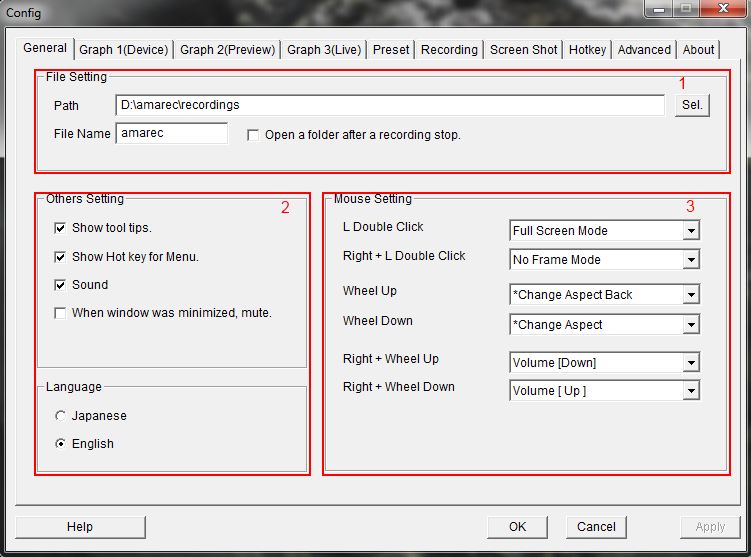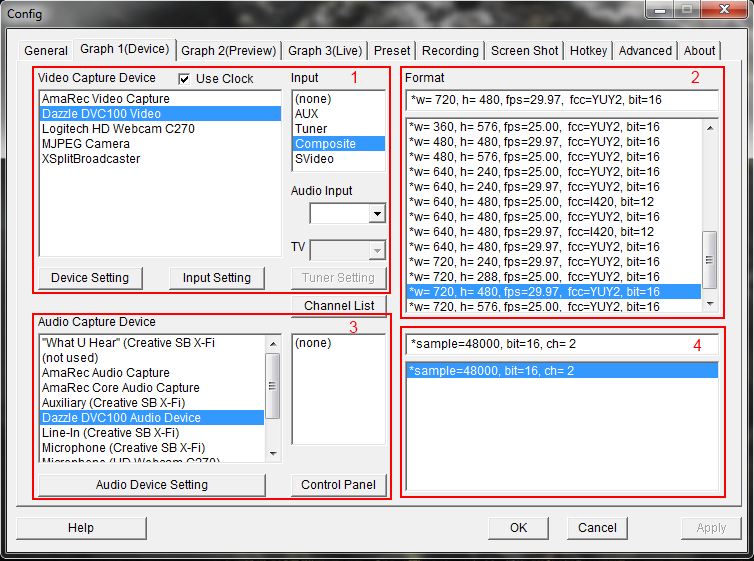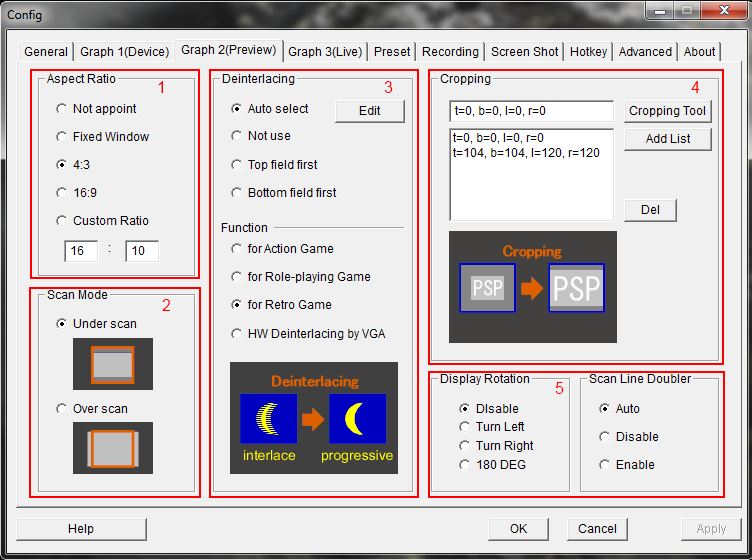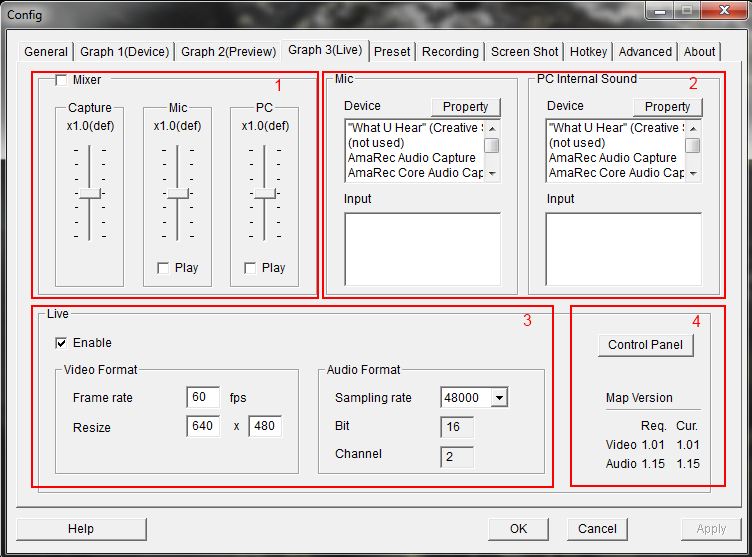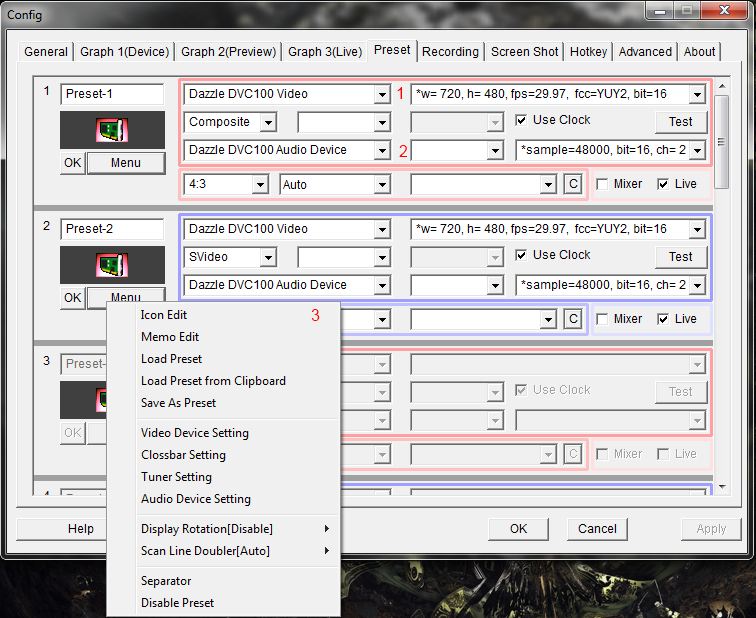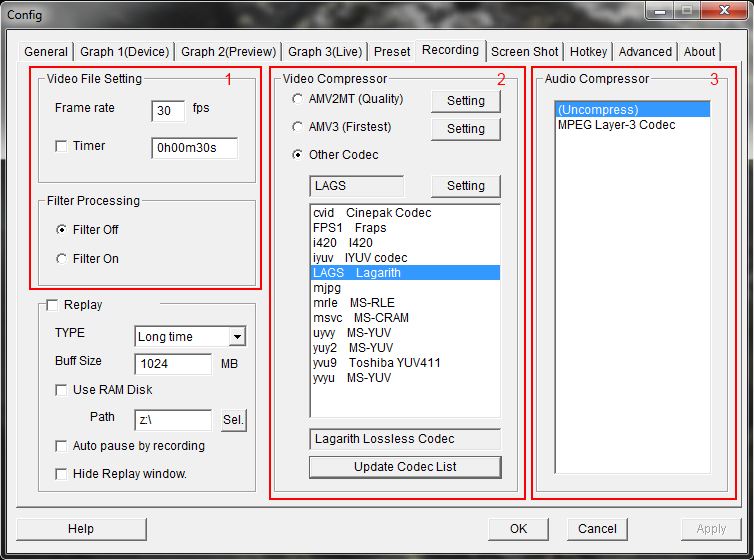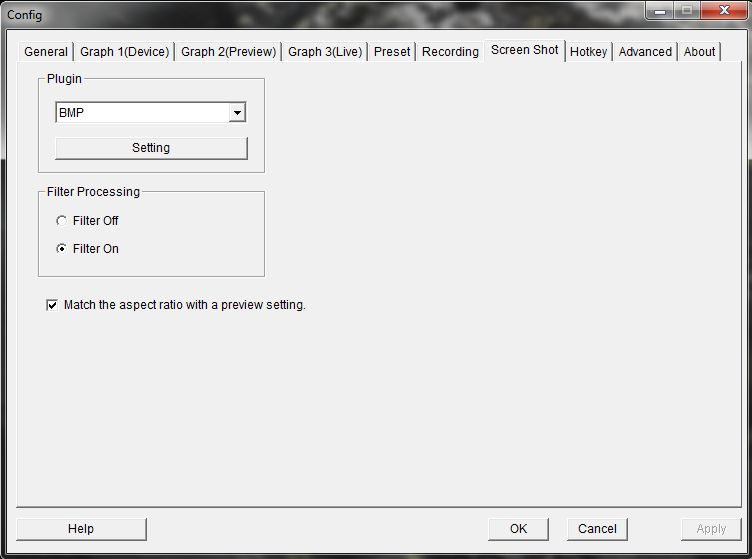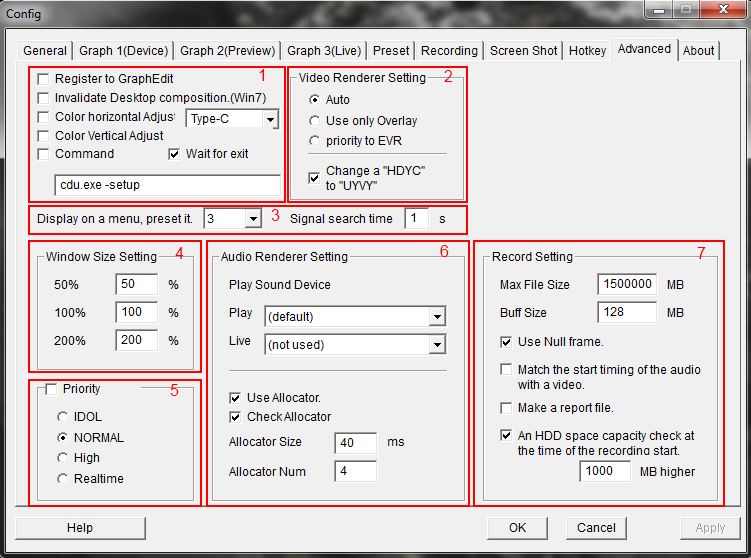Difference between revisions of "Amarectv configuration"
From SDA Knowledge Base
HonorableJay (Talk | contribs) (→Basic Setup) |
HonorableJay (Talk | contribs) (→Recording) |
||
| (10 intermediate revisions by 2 users not shown) | |||
| Line 16: | Line 16: | ||
==Graph 1(Device)== | ==Graph 1(Device)== | ||
[[File:Amarec_device.jpg|x350px]] | [[File:Amarec_device.jpg|x350px]] | ||
| − | # Here the user chooses the video device to grab footage from. This list not only lists all hardware capture devices, but also all software capture devices (like SCFH | + | |
| + | This tab is used to setup what audio and video device(s) will be used for basic capturing/streaming. Understanding all of the options here will help with using the Preset tab. | ||
| + | # Here the user chooses the video device to grab footage from. This list not only lists all hardware capture devices, but also all software capture devices (like [http://koitsu.wordpress.com/2009/09/12/how-to-install-and-use-scfh-dsf/ SCFH]). After choosing the appropriate capture device, if the device supports it, the option to choose between different capture pins (composite, s-video, component, etc) will be available. The "Use Clock" option is not fully understood at the moment, so it is recommended to leave it checked. To change advanced settings of the selected device, the "Device Setting" and "Input Setting" buttons can be used. The Audio input listbox can be left blank for most devices since it is handled by the audio section below. | ||
# This section allows the user to choose the desired capture resolution and framerate. For most users, this section will be the hardest to understand. (**Editor's Note*** Need a few links to advanced term glossary for video standards) To simplify things, here are a few basic rules to follow: | # This section allows the user to choose the desired capture resolution and framerate. For most users, this section will be the hardest to understand. (**Editor's Note*** Need a few links to advanced term glossary for video standards) To simplify things, here are a few basic rules to follow: | ||
## AmarecTv lists the options in this format: frame width, frame height, framerate, colorspace, color bit depth | ## AmarecTv lists the options in this format: frame width, frame height, framerate, colorspace, color bit depth | ||
## Composite and S-Video send an interlaced video signal, which will be seen as 29.97fps (NTSC) or 25.00fps (PAL/Secam). | ## Composite and S-Video send an interlaced video signal, which will be seen as 29.97fps (NTSC) or 25.00fps (PAL/Secam). | ||
| − | ## Component/HDMI can send a progressive video signal, which will be seen as 59. | + | ## Component/HDMI can send a progressive video signal, which will be seen as 59.94fps (NTSC) or 50fps (PAL/Secam). |
## Component CAN send an interlaced signal if the system supports it. The Nintendo Wii, Nintendo Gamecube, and Playstation 2 are good examples. (**Editor's Note*** double-check this for accuracy) | ## Component CAN send an interlaced signal if the system supports it. The Nintendo Wii, Nintendo Gamecube, and Playstation 2 are good examples. (**Editor's Note*** double-check this for accuracy) | ||
## YUY2 is the preferred colorspace to use for recording. If your capture device lists RGB as the colorspace, then that is preferred over YUY2. Every other colorspace that your device may support has a high chance of introducing artifacts into the captured footage (and artifacts are always bad). | ## YUY2 is the preferred colorspace to use for recording. If your capture device lists RGB as the colorspace, then that is preferred over YUY2. Every other colorspace that your device may support has a high chance of introducing artifacts into the captured footage (and artifacts are always bad). | ||
## Using anything less than a 16bit color depth will render the footage unusable. | ## Using anything less than a 16bit color depth will render the footage unusable. | ||
| − | # Here the user can choose which audio device to capture from. For most capture devices, the audio pin will have the same name as the video pin. However, this isn't always the case as some audio devices require workarounds to properly capture audio (Dazzle DVC100 is one known device). Therefore, it's up to the user to | + | ## Some systems use a non-standard framerate. See [http://tasvideos.org/PlatformFramerates.html this list] for reference. To ensure the most accurate recordings, the framerate can be manually typed in. For example, capturing from NES/SNES would be fps=30.0494 for NTSC systems. |
| + | # Here the user can choose which audio device to capture from. For most capture devices, the audio pin will have the same name as the video pin. However, this isn't always the case as some audio devices require workarounds to properly capture audio (Dazzle DVC100 is one known device). Therefore, it's up to the user to know what device will be capturing the audio. The "Audio Device" button will bring up the audio device's crossbar to configure advanced device settings (crossbar only comes up IF the device registers it properly, and not all devices do). The "Control Panel" button will bring up the Windows Recording Mixer to change advanced recording options for the OS. | ||
# This area will list the supported audio capture formats of the chosen audio device. The format is listed as: audio sample rate, bit depth, number of channels. | # This area will list the supported audio capture formats of the chosen audio device. The format is listed as: audio sample rate, bit depth, number of channels. | ||
| − | ## A sample rate of 48000 or 44100 are the best options. | + | ## A sample rate of 48000 or 44100 are the best options. If the footage displays an audio desync, switch between the two sample rates to see if that eliminates the problem. If not, then [[Progressive_Audio_Desync|fixing will be required.]] |
## A bit depth of 16 is the lowest acceptable for good quality footage. If your device supports a higher bit depth it can be used, but encoding programs might not support it. | ## A bit depth of 16 is the lowest acceptable for good quality footage. If your device supports a higher bit depth it can be used, but encoding programs might not support it. | ||
## Stereo (2 channel) audio is the default for nearly every capture card. Some can support multi-channel recording, but only on extremely expensive devices (which might not be supported by AmarecTv). Even if your device only outputs mono sound (Nintendo NES) always choose stereo to record since the final encode can be down-mixed to mono. | ## Stereo (2 channel) audio is the default for nearly every capture card. Some can support multi-channel recording, but only on extremely expensive devices (which might not be supported by AmarecTv). Even if your device only outputs mono sound (Nintendo NES) always choose stereo to record since the final encode can be down-mixed to mono. | ||
| + | |||
==Graph 2(Preview)== | ==Graph 2(Preview)== | ||
[[File:Amarec_preview.jpg|x350px]] | [[File:Amarec_preview.jpg|x350px]] | ||
| Line 56: | Line 60: | ||
==Preset== | ==Preset== | ||
[[File:Amarec_preset.jpg|x350px]] | [[File:Amarec_preset.jpg|x350px]] | ||
| + | |||
| + | Need to setup multiple different capture devices? How about quickly switching between composite/s-video/component/etc? Then this is your place. The preset tab is a condensed version of the device and preview tabs in one, but each preset is setup as an individual device. This lets the user setup multiple different configurations for video/audio and have a quick way to switch between them. One thing to note is that while none of the listboxes have labels (to save space) they all function exactly as they would in the device/preview tab. | ||
| + | |||
| + | # This section comprises the video device, resolution, and framerate options. | ||
| + | # Here are the audio options, and just underneath are the preview window options. | ||
| + | # Click the Menu button underneath the preset's icon and this dialog will appear. Use this to change a preset's icon (highly recommended), enable/disable the preset, and other various options. The separator option allows a user to add a separator bar on the Preview window's menu (where the presets show up as buttons) after any preset with this feature enabled. It's intended use is to help visually separate the presets, making multiple presets for different capture devices easier to keep track of. | ||
| + | |||
| + | [[File:Amarec_main_buttons.jpg|x85px]] | ||
| + | |||
| + | This is what the presets look like on the Preview window once they're setup and enabled. Section 2 on the image above shows two presets: one for composite input and the other for s-video input (both from the same device). There are 2 ways to change between the presets: | ||
| + | *Click on the preset button itself | ||
| + | *Use a hotkey (defaults are F1-F12 for the 12 presets) | ||
==Recording== | ==Recording== | ||
[[File:Amarec_recording.jpg|x350px]] | [[File:Amarec_recording.jpg|x350px]] | ||
| + | |||
| + | This tab allows the user to choose the recording framerate, duration (if desired), video codec, and audio codec. (***Editor's Note*** Need explanation on replay feature) For SDA purposes, all recordings should be in the raw, unaltered state that your capture card grabs the video. This means setting the framerate to match what your device is set to capture at (which is set by the device/preset tabs), turning off the filter (which applies the settings used in the preview tab), using a high quality video codec, and leaving the audio set to uncompressed. | ||
| + | |||
| + | # As of the latest version of Amarec, 3.10, the preferred framerate for recording should be set to 999. This will force Amarec to record in the same framerate as your device is set to capture at. For example, if you set your device to capture at fps=30.0494 for NES/SNES recording, your recorded footage will have the same framerate. If using an older version of Amarec, then you'll have to keep the recording framerate to whole numbers: Interlaced = 30 for NTSC, 25 for PAL while Progressive = 60 for NTSC and 50 for PAL. Remember to keep the Filter off unless the footage is for personal use and not intended to be submitted to SDA. | ||
| + | # The video codec to record the footage is chosen here. Amarec has it's own codec, but unless a license fee is paid there will be a watermark in the video. To use a codec installed to Windows, click the Update Codec List button at the bottom, then click on the codec of choice once the list is populated. The two most popular ones for SDA video are Huffyuv and Lagarith (shows up as LAGS on the list). If advanced features of the codec can be configured, select it and click on the Setting button just above the selection window. (***Editor's Note*** Need links for Huffyuv and Lagarith, preferably KB links) | ||
| + | # Here the supported audio codecs are listed. For SDA purposes, choose Uncompressed. Otherwise, choose whichever codec is preferred. | ||
==Screenshot== | ==Screenshot== | ||
[[File:Amarec_screenshot.jpg|x350px]] | [[File:Amarec_screenshot.jpg|x350px]] | ||
| + | |||
| + | This tab sets up the format for screenshots. Available options are: | ||
| + | *File type | ||
| + | *Applying a filter to the image | ||
| + | *Matching the aspect ratio to the Preview window | ||
==Hotkey== | ==Hotkey== | ||
[[File:Amarec_hotkey.jpg|x350px]] | [[File:Amarec_hotkey.jpg|x350px]] | ||
| + | |||
| + | Every function in AmarecTv that has an available hotkey can be configured here. The windows reads in this order: | ||
| + | *Function name | ||
| + | *Enable/Disable | ||
| + | *Tab, which immediately sets the key to the Tab button on the keyboard | ||
| + | *The current hotkey | ||
| + | *Enabled modifier keys | ||
| + | |||
| + | To change a hotkey, click on the hotkey window (which shows the actual key value, i.e. '0x70 F1'), then press the keyboard key desired to perform that function. Enabling any of the modifier keys means that the modifier key (any combination of Shift, Ctrl, Alt, and the Win key) has to be held before pressing the hotkey for the function to work. A good example is F1: by default, press F1 by itself to choose the first preset, but hold Shift and press F1 chooses the Preview Graph. | ||
==Advanced== | ==Advanced== | ||
[[File:Amarec_advanced.jpg|x350px]] | [[File:Amarec_advanced.jpg|x350px]] | ||
| + | |||
| + | This tab allows tweaking of advanced under-the-hood settings within AmarecTv. Since a lot of these settings can ruin recorded footage, it's best to leave them at the defaults. | ||
| + | |||
| + | # (***Editor's Note*** Not sure what all of these options do) | ||
| + | # This changes the video rendering mode that the Preview window uses to draw the captured video. Auto is the best option for most users. | ||
| + | # Here are options specific to using AmarecTv to watch standard TV from a tv-tuner card. The signal search time is how long Amarec will wait on a chosen channel for a signal to come through. | ||
| + | # Right clicking on the Preview window gives the user the option to quickly change the window size to either 50%, 100%, or 200% of the original captured footage resolution. This section allows the user to change the actual percentage for each option. | ||
| + | # If AmarecTv is getting in the way of other programs (or vice versa), this area allows lowering/raising the base Windows priority. Due to instability (or maybe the feature doesn't work properly?) it's best to manually set the priority in the Windows Task Manager. | ||
| + | # This area controls what devices AmarecTv plays the captured audio through. The Play option chooses the device used for captured audio directly from the source, while the Live option allows the user to listen to what audio is being sent out through the Live component. The buffer options at the bottom are used to help remove stuttering from audio playback but can possibly introduce audio lag if set too high (***Editor's Note*** check for accuracy). | ||
| + | # The last area allows tweaking of the recording system itself. The max file setting limits how large recorded footage can be, and if reached recording will stop. The buffer is how much system RAM AmarecTv will use while recording. With slow hard drives, increasing the buffer size can help reduce frame loss but will negatively impact system performance as it gets higher. The HD capacity check will make sure that a certain amount of hard drive space (which the user can input into the window, default is just shy of 1GB) is free before trying to record. This helps stability by not trying to record footage to a hard drive that doesn't have enough space left (which can crash AmarecTv or Windows). (***Editor's Note*** Need explanations on the other options since I don't know exactly how they work) | ||
Latest revision as of 20:57, 8 January 2016
Contents
Installation
The official English support page with download links can be found here. Unlike most Windows applications, AmarecTv does not need to be installed to function. Simply extract the contents of the zip file into any folder and it's all set to run. There are a few recommendations that can make using the program easier.
- Avoid 'Program Files' - Due to the way Windows handles applications installed to the 'Program Files' and 'Program Files (x86)' directories it's best to install outside of them. The easiest place to use would be the root of a hard drive (c:\amarec or d:\amarec are two commonly used places).
- Run As Admin - For Vista/Win7/Win8, make sure to run AmarecTv with Administrator rights to avoid random crashes. Right click on amarec.exe, then click properties on the context menu. When the next window appears, click on the compatibility tab. Near the bottom you'll see a checkbox option to run as administrator. Click the checkbox to enable it, then click OK to save the changes.
- Install/Record to secondary hard drive - Running AmarecTv and recording to a secondary hard drive that Windows is not installed to will help avoid the OS from interfering with the recording process (which can lead to dropped frames and AV desync).
Basic Setup
To make following each section easier, each area has been highlighted and numbered. Under each image is a numbered explanation corresponding to each highlighted region.
General Tab
- This section let's the user choose which folder to save recorded footage in, and also what the default name for the file should be. The folder chosen has to exist before AmarecTv can record to it, so make sure you create it before trying to save your changes here. For the file name, it is always followed by the date it was recorded. So if you choose the default file name (amarec), the resulting file will look similar to amarec(20130409-0007).avi
- General settings can be turned on or off (like whether or not the program emits sounds upon events like starting/stopping a recording) along with changing the program's display language.
- How the mouse interacts with the program can be setup here.
Graph 1(Device)
This tab is used to setup what audio and video device(s) will be used for basic capturing/streaming. Understanding all of the options here will help with using the Preset tab.
- Here the user chooses the video device to grab footage from. This list not only lists all hardware capture devices, but also all software capture devices (like SCFH). After choosing the appropriate capture device, if the device supports it, the option to choose between different capture pins (composite, s-video, component, etc) will be available. The "Use Clock" option is not fully understood at the moment, so it is recommended to leave it checked. To change advanced settings of the selected device, the "Device Setting" and "Input Setting" buttons can be used. The Audio input listbox can be left blank for most devices since it is handled by the audio section below.
- This section allows the user to choose the desired capture resolution and framerate. For most users, this section will be the hardest to understand. (**Editor's Note*** Need a few links to advanced term glossary for video standards) To simplify things, here are a few basic rules to follow:
- AmarecTv lists the options in this format: frame width, frame height, framerate, colorspace, color bit depth
- Composite and S-Video send an interlaced video signal, which will be seen as 29.97fps (NTSC) or 25.00fps (PAL/Secam).
- Component/HDMI can send a progressive video signal, which will be seen as 59.94fps (NTSC) or 50fps (PAL/Secam).
- Component CAN send an interlaced signal if the system supports it. The Nintendo Wii, Nintendo Gamecube, and Playstation 2 are good examples. (**Editor's Note*** double-check this for accuracy)
- YUY2 is the preferred colorspace to use for recording. If your capture device lists RGB as the colorspace, then that is preferred over YUY2. Every other colorspace that your device may support has a high chance of introducing artifacts into the captured footage (and artifacts are always bad).
- Using anything less than a 16bit color depth will render the footage unusable.
- Some systems use a non-standard framerate. See this list for reference. To ensure the most accurate recordings, the framerate can be manually typed in. For example, capturing from NES/SNES would be fps=30.0494 for NTSC systems.
- Here the user can choose which audio device to capture from. For most capture devices, the audio pin will have the same name as the video pin. However, this isn't always the case as some audio devices require workarounds to properly capture audio (Dazzle DVC100 is one known device). Therefore, it's up to the user to know what device will be capturing the audio. The "Audio Device" button will bring up the audio device's crossbar to configure advanced device settings (crossbar only comes up IF the device registers it properly, and not all devices do). The "Control Panel" button will bring up the Windows Recording Mixer to change advanced recording options for the OS.
- This area will list the supported audio capture formats of the chosen audio device. The format is listed as: audio sample rate, bit depth, number of channels.
- A sample rate of 48000 or 44100 are the best options. If the footage displays an audio desync, switch between the two sample rates to see if that eliminates the problem. If not, then fixing will be required.
- A bit depth of 16 is the lowest acceptable for good quality footage. If your device supports a higher bit depth it can be used, but encoding programs might not support it.
- Stereo (2 channel) audio is the default for nearly every capture card. Some can support multi-channel recording, but only on extremely expensive devices (which might not be supported by AmarecTv). Even if your device only outputs mono sound (Nintendo NES) always choose stereo to record since the final encode can be down-mixed to mono.
Graph 2(Preview)
This tab is used to setup the preview window for AmarecTv. A few things to note: (***Editor's Note*** Check for accuracy)
- Scan Mode (Overscan/Underscan), Deinterlacer, Cropping, Rotation, and Scanline Doubler all affect AmarecTv's Live output.
- Cropping and Scan Mode will affect any recorded footage.
- The Aspect Ratio determines whether the actual Preview window is locked in a specific aspect (4/3, 16/9, custom) or if it's determined simply by the size of the window itself. Auto is the preferred option, but if your display looks strange locking in a specific aspect ratio will fix things. Older consoles before the PS2/Xbox usually display in 4/3 mode, while anything PS2 and up can display in either 4/3 or 16/9 even in standard definition resolutions.
- The Scan Mode determines how much of the source image (the signal coming from your capture device) to display. Older CRT televisions, while they supported resolutions like 720x480 (NTSC) or 720x576 (PAL/Secam), would only display most of the image. The outer regions of the screen were usually outside of the screen itself. To get around this issue and make sure that games and basic television were displayed properly, a lot of older systems would pad the signal with a colored border. Since CRT's never displayed the border regions, most people didn't even know the border existed at all. For newer HDTVs and capture cards, the entire image is displayed including the border. Setting the scan mode to Underscan shows the entire image including the borders. Choosing Overscan attempts to emulate the way older CRTs displayed images and cut out the border. Since this setting will affect recorded footage, it's best to leave it set to Underscan and simply crop the image during the encoding process.
- AmarecTv has a very quick and decent-quality on-the-fly deinterlacer (click here for an explanation as to what interlaced footage is) that can remove the sawblades and restore full-framerate picture to the preview window when capturing from a composite/s-video source (also component that isn't sending a progressive signal). Another benefit is that this will enable 60fps streaming to AmarecTv's Live output. Auto Select attempts to determine how the video source is setup and will choose the appropriate field mode. If the footage jerks back and forth, then AmarecTv has chosen the wrong mode and it's best to force either Top Field or Bottom Field to see which option removes the jittering. If you're capturing progressive footage (usually over component or HDMI) then using Auto or Not Use are recommended. Underneath the first set of options, you'll see the Deinterlacing Mode options. Here you'll tell AmarecTv what type of footage you plan on recording which will help make the deinterlacer work better. Most older systems (NES, Genesis, Master System, and some SNES games) will require the Retro Game option. The Action Game setting is supposed to work best for fast paced games with quick moving images. Role-Playing Game is designed for games that have almost no screen motion. HW by VGA is supposed to rely on your video card's deinterlacing methods, although this hasn't been completely confirmed. If you know that you have the correct field selection (top/bottom first) but the video still looks weird (either bobbing or slight jittering) try choosing another mode to see if that helps.
- The Cropping tool is to give the user a more advanced method of getting rid of screen borders. The image uses the Playstation Portable as an example, but it can be used with any source. Clicking on the Cropping Tool button brings up a simple dialog for the user to dial in the appropriate settings while the preview tab is playing in the background. The format (in pixels) for manually adding is: top, bottom, left, right. An example would be: t=10, b=23, l=52, r=55. Once manually typed in, clicking Add List will permanently save that specific setting to a hotlist and can be used later by clicking on it.
- The last section details the screen rotation and scan-line doubler. For most capture footage (outside of arcade games), leaving the rotation to disabled is the best choice. As for the Scan-Line Doubler, this depends on the footage you're capturing AND the aspect ratio that's selected. Under most circumstances the doubler will do nothing. The idea is that when interlaced footage has the fields split to create 2 individual images, the vertical resolution will be cut in half. To fix this, the easiest method is to simply double every vertical pixel. By forcing a specific aspect ratio, every vertical pixel will be scaled accordingly, thus rendering the scan-line doubler practically ineffective. By using the Auto setting, AmarecTv will enable the doubler when needed. Unfortunately, when it is deemed needed has not been fully determined yet, so choosing either Auto or Disabled will normally produce the same effect. (***Editor's Note*** Does anybody know just how the scan-line doubler works?)
Graph 3(Live)
AmarecTv's Live component allows the user to have a virtual device that other programs can use to capture. This comes in handy when capturing footage with AmarecTv and at the same time streaming the same footage with a program like XSplit or OBS.
- If the user needs to mix different audio streams together to make streaming easier, the mixer can easily handle most tasks. The options available are the Capture audio (which is determined by the Device tab), Mic audio, and the PC Sounds. By checking the Mixer button, this feature is enabled and all 3 types of audio can be set to independent volume levels.
- This section allows the user to choose what Amarec considers the microphone source and the pc sound source. After clicking on what device should be used for the Mic/PC sources, the available capture settings will appear in the listboxes below (in the same manner as setting up the Capture Device audio settings).
- The Live section actually enables AmarecTv's Live feature. First, check the box next to Live to turn it on. Then, choose the resolution and framerate you wish to use. If possible, try to match the resolution your TV would be displaying. For NTSC standard definition, that would be 720x480 or 640x480, and for PAL/Secam standard definition that would be 720x576 (***Editor's Note*** Need confirmation on SD PAL resolutions). For framerate, this will depend on what you've setup in your Preview tab. If the deinterlacer is enabled, it's safe to use 60 for NTSC and 50 for PAL/Secam. If the point is to stream HD streams, then 1280x720 will be used for 720p, and 1920x1080 will be used for 1080p. A few notes about the framerates used here (***Editor's Note*** Need a new FAQ explaining dimensions/framerate for newbies):
- NTSC uses 29.97 for F2 and 59.94 for F1.
- PAL/Secam uses 25.00 for F2 and 50.00 for F2.
- Using 30/60 for NTSC will not adversely affect the stream since AmarecTv simply uses the framerate as a target and will not exceed the incoming framerate from the device itself.
- This section is simply present to show the required version of AmarecTv's Live component for the user's running version of AmarecTv and the version of Live that the user has installed. Clicking on the Control Panel button simply loads the Windows Audio Mixer panel which chooses the default recording/playback devices.
Preset
Need to setup multiple different capture devices? How about quickly switching between composite/s-video/component/etc? Then this is your place. The preset tab is a condensed version of the device and preview tabs in one, but each preset is setup as an individual device. This lets the user setup multiple different configurations for video/audio and have a quick way to switch between them. One thing to note is that while none of the listboxes have labels (to save space) they all function exactly as they would in the device/preview tab.
- This section comprises the video device, resolution, and framerate options.
- Here are the audio options, and just underneath are the preview window options.
- Click the Menu button underneath the preset's icon and this dialog will appear. Use this to change a preset's icon (highly recommended), enable/disable the preset, and other various options. The separator option allows a user to add a separator bar on the Preview window's menu (where the presets show up as buttons) after any preset with this feature enabled. It's intended use is to help visually separate the presets, making multiple presets for different capture devices easier to keep track of.
This is what the presets look like on the Preview window once they're setup and enabled. Section 2 on the image above shows two presets: one for composite input and the other for s-video input (both from the same device). There are 2 ways to change between the presets:
- Click on the preset button itself
- Use a hotkey (defaults are F1-F12 for the 12 presets)
Recording
This tab allows the user to choose the recording framerate, duration (if desired), video codec, and audio codec. (***Editor's Note*** Need explanation on replay feature) For SDA purposes, all recordings should be in the raw, unaltered state that your capture card grabs the video. This means setting the framerate to match what your device is set to capture at (which is set by the device/preset tabs), turning off the filter (which applies the settings used in the preview tab), using a high quality video codec, and leaving the audio set to uncompressed.
- As of the latest version of Amarec, 3.10, the preferred framerate for recording should be set to 999. This will force Amarec to record in the same framerate as your device is set to capture at. For example, if you set your device to capture at fps=30.0494 for NES/SNES recording, your recorded footage will have the same framerate. If using an older version of Amarec, then you'll have to keep the recording framerate to whole numbers: Interlaced = 30 for NTSC, 25 for PAL while Progressive = 60 for NTSC and 50 for PAL. Remember to keep the Filter off unless the footage is for personal use and not intended to be submitted to SDA.
- The video codec to record the footage is chosen here. Amarec has it's own codec, but unless a license fee is paid there will be a watermark in the video. To use a codec installed to Windows, click the Update Codec List button at the bottom, then click on the codec of choice once the list is populated. The two most popular ones for SDA video are Huffyuv and Lagarith (shows up as LAGS on the list). If advanced features of the codec can be configured, select it and click on the Setting button just above the selection window. (***Editor's Note*** Need links for Huffyuv and Lagarith, preferably KB links)
- Here the supported audio codecs are listed. For SDA purposes, choose Uncompressed. Otherwise, choose whichever codec is preferred.
Screenshot
This tab sets up the format for screenshots. Available options are:
- File type
- Applying a filter to the image
- Matching the aspect ratio to the Preview window
Hotkey
Every function in AmarecTv that has an available hotkey can be configured here. The windows reads in this order:
- Function name
- Enable/Disable
- Tab, which immediately sets the key to the Tab button on the keyboard
- The current hotkey
- Enabled modifier keys
To change a hotkey, click on the hotkey window (which shows the actual key value, i.e. '0x70 F1'), then press the keyboard key desired to perform that function. Enabling any of the modifier keys means that the modifier key (any combination of Shift, Ctrl, Alt, and the Win key) has to be held before pressing the hotkey for the function to work. A good example is F1: by default, press F1 by itself to choose the first preset, but hold Shift and press F1 chooses the Preview Graph.
Advanced
This tab allows tweaking of advanced under-the-hood settings within AmarecTv. Since a lot of these settings can ruin recorded footage, it's best to leave them at the defaults.
- (***Editor's Note*** Not sure what all of these options do)
- This changes the video rendering mode that the Preview window uses to draw the captured video. Auto is the best option for most users.
- Here are options specific to using AmarecTv to watch standard TV from a tv-tuner card. The signal search time is how long Amarec will wait on a chosen channel for a signal to come through.
- Right clicking on the Preview window gives the user the option to quickly change the window size to either 50%, 100%, or 200% of the original captured footage resolution. This section allows the user to change the actual percentage for each option.
- If AmarecTv is getting in the way of other programs (or vice versa), this area allows lowering/raising the base Windows priority. Due to instability (or maybe the feature doesn't work properly?) it's best to manually set the priority in the Windows Task Manager.
- This area controls what devices AmarecTv plays the captured audio through. The Play option chooses the device used for captured audio directly from the source, while the Live option allows the user to listen to what audio is being sent out through the Live component. The buffer options at the bottom are used to help remove stuttering from audio playback but can possibly introduce audio lag if set too high (***Editor's Note*** check for accuracy).
- The last area allows tweaking of the recording system itself. The max file setting limits how large recorded footage can be, and if reached recording will stop. The buffer is how much system RAM AmarecTv will use while recording. With slow hard drives, increasing the buffer size can help reduce frame loss but will negatively impact system performance as it gets higher. The HD capacity check will make sure that a certain amount of hard drive space (which the user can input into the window, default is just shy of 1GB) is free before trying to record. This helps stability by not trying to record footage to a hard drive that doesn't have enough space left (which can crash AmarecTv or Windows). (***Editor's Note*** Need explanations on the other options since I don't know exactly how they work)
